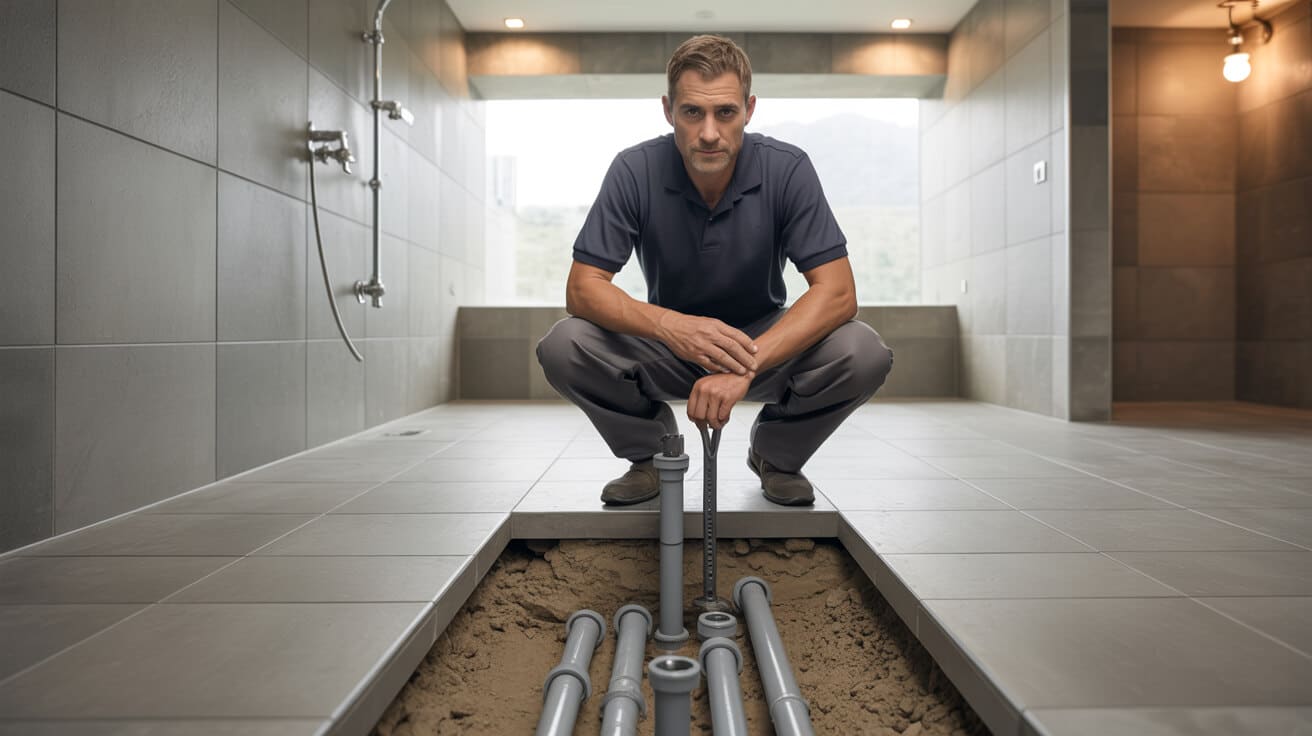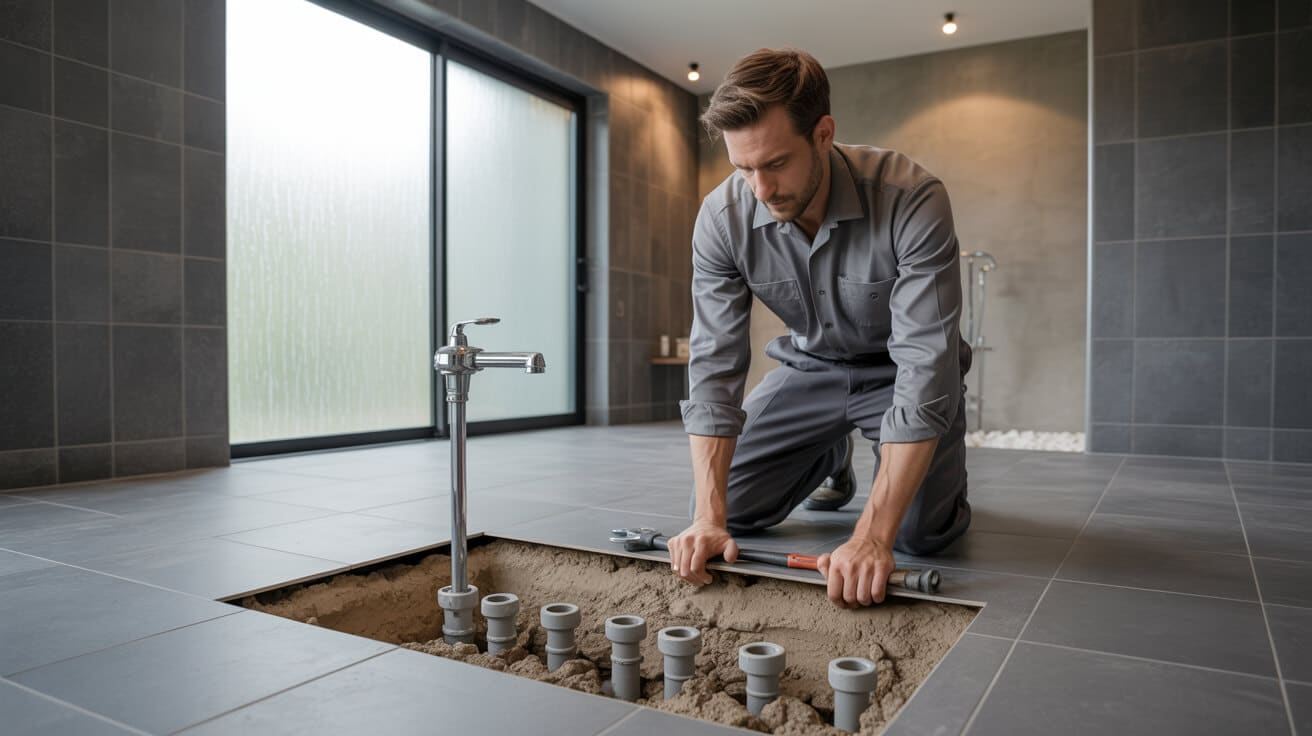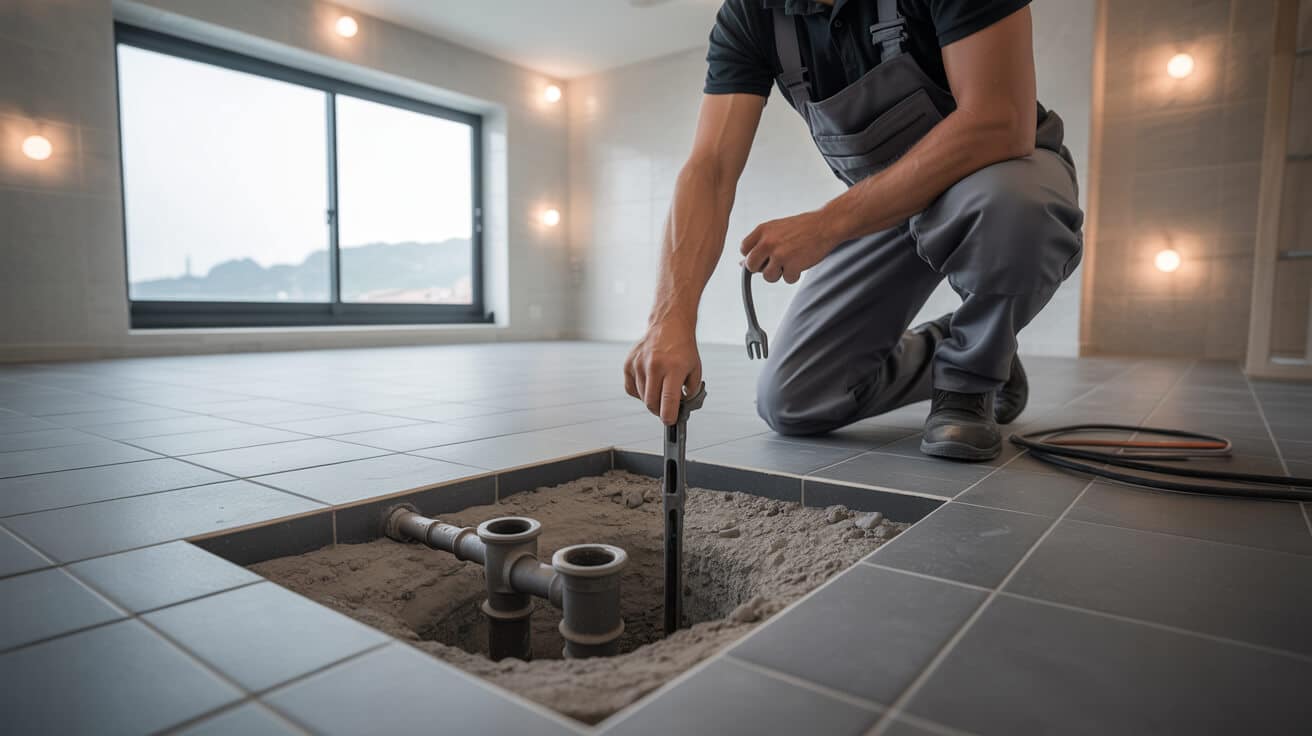Drain pipe excavation replacement is a critical service for maintaining the integrity of building drainage systems. Ageing pipes, structural failures, and persistent blockages necessitate a comprehensive replacement process that minimises disruption while ensuring the long-term reliability of the drainage infrastructure. This procedure encompasses thorough site assessments, regulatory compliance, precise technical execution, and meticulous restoration of the affected area.
Etymology or Name Origin
The terminology in drain pipe excavation replacement stems from Latin origins, where “excavation” (from excavare) implies the act of hollowing out and removing material. The term “drain pipe” identifies the conduit through which wastewater is discharged, while “replacement” denotes the process of installing a new system in lieu of the old, malfunctioning one. Historically, these terms have evolved in the plumbing trade as techniques have advanced from manual digging to sophisticated, mechanised excavation methods.
Overview / Context
Drain pipe excavation replacement addresses the essential need to preserve and enhance building drainage systems. This process is implemented when existing pipes show signs of degradation due to corrosion, blockage, or structural compromise, ultimately affecting water flow and leading to water damage. It is positioned as an intersection between traditional plumbing practices and modern, technologically driven methods that include safety assessments, precise excavation, and contemporary installation techniques. In the broader context of property maintenance, effective drainage replacement safeguards structural integrity and supports the long-term durability of both residential and commercial buildings.
History
The history of drain pipe excavation replacement reflects a progression from rudimentary, manual maintenance techniques to modern, highly engineered processes. In early plumbing practices, drainage systems were maintained using basic hand tools for small-scale repairs. As urbanisation increased in the industrial era, the demand for reliable drainage systems escalated, leading to the development of more systematic excavation and pipe replacement practices.
Technological advancements in the second half of the twentieth century introduced mechanised excavation equipment and innovative techniques, such as trenchless technology, which minimises surface disruption. The evolution of regulatory standards—from early building codes to contemporary mandates such as the WRAS guidelines and Building Regulations Part H—has further refined these processes, ensuring both safety and environmental compliance. The historical transition demonstrates an ongoing commitment within the plumbing industry to enhance service quality while managing increasingly complex infrastructural demands.

Concept / Description
Drain pipe excavation replacement is a multifaceted process that entails several interrelated steps aimed at replacing outdated or compromised drainage systems. At its core, the process involves a detailed site survey, careful excavation to expose the damaged drainage, the removal of the old pipework, and the installation of new, compliant pipes.
Key elements of this process include:
- Excavation: Employing both mechanised and manual techniques to remove soil and debris, ensuring safe access to buried drain pipes.
- Removal: Segmenting and disposing of old or deteriorated pipes using cutting and breaking techniques.
- Installation: Aligning and connecting new pipes using appropriate jointing methods (such as soldered, compression, or push-fit joints) while ensuring proper slope and system integration.
- Restoration: Backfilling, compacting the soil, and restoring the site to its pre-excavation condition, including any necessary paving or landscaping.
This process is designed to mitigate recurring problems such as water leaks, blockages, and structural damage, thereby promoting backflow prevention and optimal drainage performance.
Functionality / Purpose / Applications
Drain pipe excavation replacement serves the primary function of restoring an effective drainage system, crucial for the health and longevity of a property. The process is undertaken for several key applications:
- Residential Properties: In homes, especially older constructions, replacement is necessary to prevent water damage, reduce damp issues, and maintain structural integrity.
- Commercial and Institutional Buildings: For offices, care homes, and schools, efficient drainage systems are vital to avoid operational disruptions and comply with regulatory standards.
- Industrial Facilities: In environments subject to high usage and potential chemical exposures, robust drainage systems are essential to ensure safety and prevent environmental contamination.
- Property Management: Landlords and property managers utilise scheduled maintenance programmes that include pipe excavation and replacement to maintain compliance with regulations and protect asset value.
The process offers tangible benefits including improved water flow, enhanced system efficiency, reduced risks of future repairs, and a sustained reduction in maintenance costs over time.
Classifications / Types / Variants
Drain pipe replacement techniques are classified based on the method of excavation and the materials used: 1. Traditional Open Trench Excavation:
- Process: Involves digging a continuous trench along the pipe’s length, removing the compromised pipe, and installing a new one.
- Suitability: Typically used in less congested areas where surface disruption is acceptable.
- Trenchless Technology:
- Methods: Includes techniques such as pipe bursting and relining, which replace pipework without extensive excavation.
- Benefits: Minimises disruption on roadways or in urban environments, while reducing restoration costs.
- Material Variants:
- PVC: Known for its durability and resistance to corrosion, is widely used in modern installations.
- HDPE: Offers flexibility and high strength, particularly in unstable soil conditions.
- Cast Iron: Preferred in commercial settings where higher pressure and longevity are required.
The classification further encompasses different jointing methods such as solvent welding, compression fittings, and push-fit systems, each tailored to meet specific installation and operational demands.
Systems / Tools / Methodologies
Multiple systems and tools are integrated to ensure the efficiency and safety of drain pipe excavation replacement:
- Pre-Excavation Survey Tools:
- Ground-Penetrating Radar (GPR): Assists in mapping underground utilities and pipes to avoid unintended damage.
- Laser Levelling: Ensures accurate measurement of slopes and proper alignment.
- Excavation Equipment:
- Excavators and Trenchers: Facilitate the removal of large volumes of soil quickly and accurately.
- Manual Tools: Shovels, spades, and digging bars are used for fine-tuned excavation and access to confined areas.
- Safety and Shoring Systems:
- Trench Shoring and Brackets: Provide stability to excavation walls to prevent collapses.
- Barrier and Signage: Inform and protect workers and the public during the excavation process.
- Pipe Removal and Installation Techniques:
- Cutting Tools: Reciprocating saws, hydraulic cutters, and angle grinders help segment old pipes.
- Jointing and Connection Methods: Soldering, compression fittings, and push-fit tools ensure a leak-proof connection for new pipes.
- Testing and Quality Assurance:
- Hydrostatic and Pressure Testing: Validate the integrity of newly installed systems.
- Digital Inspection Devices: Pressure gauges and flow metres confirm that the new system operates within designed parameters.
- Restoration Procedures:
- Backfilling Techniques: Use layered soil compaction methods to restore the site.
- Landscape Reinstatement: Involves restoring pavement, landscaping, and other surface conditions to their original state.
A comprehensive table of equipment and tools is provided below:
| Equipment/Tool | Purpose | Example/Specification |
|---|---|---|
| Ground-Penetrating Radar | Mapping underground utilities | GPR device, frequency 900 MHz |
| Excavator | Removing large volumes of soil | 5-tonne mini excavator |
| Laser Level | Ensuring accurate slope and alignment | Digital laser level with inclinometer |
| Hydraulic Cutter | Segmenting old pipework | High-pressure hydraulic pipe cutter |
| Shoring Kits | Stabilising trench walls | Adjustable trench shoring system |
| Pressure Gauge | Testing system integrity | Digital pressure gauge with range 0-250 psi |
| Flow Metre | Measuring water flow efficiency | Inline flow metre |

Stakeholders / Entities Involved
The successful execution of drain pipe excavation replacement requires coordination among multiple stakeholders:
- Plumbing Contractors and Excavation Specialists:
These professionals execute the technical aspects including excavation, pipe removal, and installation of new drainage systems.
- Site Surveyors and Safety Inspectors:
They conduct pre-excavation surveys, utilise diagnostic tools, and ensure that all steps comply with safety protocols.
- Compliance and Certification Authorities:
These entities ensure adherence to regulatory frameworks, such as WRAS standards, Building Regulations, and G3 certification.
- Property Owners, Landlords, and Property Managers:
They engage the services to maintain and upgrade drainage systems, safeguarding property value and ensuring regulatory compliance.
- Environmental and Waste Management Bodies:
They oversee the disposal of excavation debris and promote sustainable practices in waste management and site restoration.
Each stakeholder plays an integral role in the thorough planning, safe execution, and long-term monitoring of the process.
Legal / Regulatory / Ethical Considerations
Drain pipe excavation replacement is subject to several legal and regulatory requirements ensuring safety and environmental protection:
- Building Regulations:
In the United Kingdom, regulations such as Part H stipulate compliance in drainage and waste disposal, while other parts prescribe requirements regarding energy use and structural safety.
- WRAS Standards:
New installations must meet the criteria set by the Water Regulations Advisory Scheme, ensuring that materials and workmanship satisfy industry benchmarks.
- G3 Certification:
For unvented hot water systems, compliance with G3 standards is mandatory, ensuring proper safety measures are in place during installation.
- Health and Safety Legislation:
Comprehensive safety protocols governed by the Health and Safety at Work Act require detailed risk assessments, the use of appropriate safety equipment, and constant monitoring of excavation sites.
- Environmental Regulations:
Companies must also adhere to environmental guidelines which cover waste management, soil erosion prevention, and water contamination controls.
- Ethical Considerations:
Ethical operation mandates transparency in pricing, adherence to best practices in waste recycling, and robust communication with clients.
Compliance with these frameworks not only ensures legal conformity but also enhances the credibility and long-term sustainability of service delivery.
Performance Metrics / Data / Measurements
Evaluating the efficacy of drain pipe excavation replacement projects relies on various objective metrics:
- Hydrostatic and Pressure Testing:
These tests determine whether the new drainage system can maintain required pressure levels without leakage. Consistent hydrostatic tests are critical markers of installation quality.
- Flow Rate Measurement:
Devices are deployed to measure water flow through the drainage system, ensuring that the new installation meets design specifications.
- Quality Assurance Benchmarks:
industry standards provide benchmarks against which the performance of the new installation is gauged. Regular monitoring ensures adherence to these standards.
- System Integrity Documentation:
Detailed test reports, including pressure readings, test durations, and corrective actions taken during installation, form part of a rigorous quality assurance framework.
- Customer Feedback:
Though primarily qualitative, customer satisfaction surveys regarding site restoration and functional improvements offer valuable data for continuous service enhancement. These metrics provide the quantitative basis for understanding the success of a replacement project and for ensuring long-term system reliability.
Challenges / Barriers / Limitations
Numerous challenges can affect the efficiency and outcome of drain pipe excavation replacement projects. These are typically grouped under operational, technical, and socio-economic factors:
- Operational and Technical Challenges:
- Utility Interference: The presence of underground cables, water mains, and gas pipelines can complicate excavation. Pre-excavation surveys are thus essential.
- Soil and Environmental Conditions: Variability in soil type, moisture, and ground stability may necessitate specialised excavation techniques and equipment.
- Material and Jointing Constraints: Ensuring the new pipework integrates well with the existing system without risk of leakage or misalignment poses significant technical demands.
- Economic and Social Factors:
- Cost Implications: The overall expense of excavation replacement, driven by labour, material, and equipment costs, can be a deterrent. Accurate quoting and budget management are imperative.
- Disruption to Operations: Especially in urban or commercial environments, the disruption caused by excavation can affect daily operations. Proper scheduling and traffic management help mitigate these issues.
- Compliance and Regulatory Hurdles: Stringent regulations require detailed documentation and adherence to safety protocols, sometimes leading to project delays.
- Logistical and Environmental Barriers:
- Site Restoration Complexity: Returning the excavated area to its original state (or better) often involves extensive backfilling, landscape rehabilitation, or pavement replacement.
- Weather Conditions: Adverse weather can halt excavation or compromise safety, increasing the risk of delays and additional costs.
- Waste and Debris Management: Proper disposal and recycling of removed materials must be managed effectively to comply with environmental regulations.
- Coordination Among Multiple Stakeholders: The need for clear communication between contractors, surveyors, compliance inspectors, and property owners can present logistical challenges.
Addressing these challenges requires a blend of precise planning, advanced technical expertise, and stringent adherence to regulatory and environmental guidelines.
Impact / Influence / Legacy
The long-term impact of drain pipe excavation replacement extends beyond immediate functional improvements:
- Infrastructure Resilience:
Effective replacement ensures that drainage systems operate reliably, reducing the risk of water damage and structural degradation. This enhances the overall resiliency of a property.
- Economic Benefits:
Properties that maintain up-to-date drainage systems often experience reduced maintenance costs and improved property values. This can be particularly beneficial for residential, commercial, and industrial sectors.
- Advancement of Industry Practices:
As more companies adopt advanced methodologies, there is a collective elevation in industry standards. The incorporation of trenchless technologies and precise diagnostic tools sets new benchmarks for safety and efficiency.
- Environmental and Social Benefits:
Implementing environmentally responsible practices such as proper debris recycling and sustainable backfilling methods contributes to reduced environmental impact, a critical aspect for urban planning and public safety.
- Historical Legacy and Knowledge Sharing:
Documented case studies and performance reports from drain pipe excavation replacement projects enrich the collective knowledge base, informing future regulation updates and technological advancements within the plumbing and heating industry. These cumulative impacts help shape the legacy of drain pipe replacement as a cornerstone of modern property maintenance and infrastructure management.
Future directions, cultural relevance, and design discourse
Emerging trends and innovations are poised to redefine the landscape of drain pipe excavation replacement:
Technological Innovation
Advances in sensor integration and data analytics are paving the way for predictive maintenance techniques. Smart sensor technologies that monitor pipe integrity in real time could enable preemptive replacements, reducing emergency repairs. Additionally, the refinement of trenchless methods continues to limit surface disruption, especially in urban settings where minimising environmental and operational impact is paramount.
Regulatory Evolution and Standardisation
Future regulatory frameworks are likely to incorporate stricter efficiency and sustainability standards. Enhanced guidelines regarding waste recycling, soil stabilisation, and energy consumption during excavation are expected. These changes will drive the adoption of newer materials that promise longer lifespans and better performance. Updated certifications and recurring professional training will further raise the standard of workmanship.
Material Advancements and Sustainable Practices
Research into innovative pipe materials continues to advance. New polymers and composites that offer superior resistance to corrosion and chemical degradation may soon be adopted as standard. Alongside these materials, strategies for sustainable excavation—such as utilising eco-friendly backfill materials and improved waste management protocols—will underscore efforts to reduce carbon footprints while maintaining operational efficiency.
Integration with Urban and Environmental Planning
The role of drain pipe excavation replacement is anticipated to expand within the framework of smart city initiatives. As urban spaces face increased pressure to manage water sustainably, drainage systems that integrate with broader municipal planning will become more common. Future projects might feature seamless collaboration between public authorities and service providers to ensure that drainage maintenance is a component of comprehensive urban resilience strategies.
Cultural and Economic Considerations
Shifts in market dynamics and cultural attitudes toward property maintenance are influencing how these projects are perceived. Customers now demand services that not only meet technical standards but also incorporate transparent, ethical practices. As such, the approach to drain pipe replacement is evolving from a reactive measure to a proactive one that prioritises customer safety, regulatory compliance, and value creation. This evolving corporate ethos is likely to be mirrored through the software solutions and digital platforms employed in managing these projects, marking a significant transformation in industry practices.
Design Discourse and Future Research
Ongoing dialogue among industry experts, academics, and regulatory bodies is expected to foster a deeper understanding of long-term degradation processes and alternative repair methodologies. Future research may focus on developing advanced simulation models that predict drainage system performance under varied environmental conditions. Such insights could drive further innovation in installation techniques, materials development, and process optimization.
| Future Trend | Description |
|---|---|
| Smart Maintenance Systems | Real-time monitoring, predictive analytics, and automated diagnostics. |
| Trenchless Technology | Continued expansion and refinement of minimally invasive methods. |
| Eco-friendly Materials | The development of sustainable, high-durability pipe materials. |
| Regulatory Upgrades | Stricter guidelines emphasising energy efficiency and environmental impact. |
| Digital Twin Modelling | Advanced simulation tools to forecast system performance and plan proactive maintenance. |
As this field evolves, drain pipe excavation replacement will continue to serve as a paradigm for integrating technological innovation with robust regulatory frameworks. The confluence of enhanced diagnostic techniques, sustainable practices, and advanced construction methodologies places this process at the forefront of modern infrastructure maintenance. Over time, these developments will not only speak to the technical superiority of such installations but also to their cultural and economic relevance within a dynamically evolving built environment.
By embracing these emerging trends, companies such as Plumbers 4U reinforce their commitment to quality and compliance while positioning themselves as leaders in the field. The integration of state-of-the-art technologies and sustainable practices ensures that drain pipe excavation replacement remains both a current necessity and a future-focused innovation.
Through this evolving narrative, the field stands to benefit from increased efficiency, reduced environmental impact, and heightened trust among clients and stakeholders alike. Innovations in methodology, laboratory benchmarking, and performance analytics will drive continual advancements, ensuring that each replacement project is executed with precision and that standards are rigorously maintained across the board.
This detailed exposition presents drain pipe excavation replacement as a multidimensional discipline. It not only fulfils an immediate technical need but also contributes significantly to the broader dialogue on infrastructure sustainability, regulatory progress, and technological innovation in plumbing and heating systems. The ongoing commitment to excellence in this field illustrates the dynamic interplay between industrial practices, regulatory imperatives, and the drive for operational efficiency—a balance that ultimately enhances the reliability and safety of the built environment.
In sum, drain pipe excavation replacement is an evolving practice that encapsulates the convergence of traditional technical expertise with contemporary innovation. Its role in ensuring safe, effective drainage is indispensable, and its continual evolution promises to further enhance the maintenance and performance of buildings, thereby fostering improved environmental outcomes and bolstering economic value across diverse property types.

